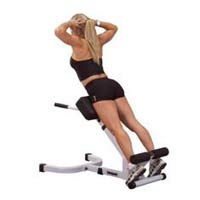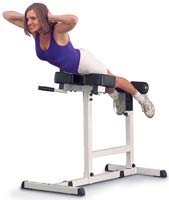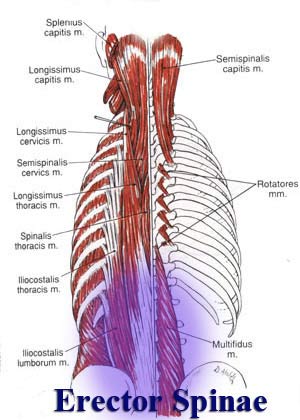- Like
- SHARE
- Digg
- Del
- Tumblr
- VKontakte
- Flattr
- Buffer
- Love This
- Save
- Odnoklassniki
- Meneame
- Blogger
- Amazon
- Yahoo Mail
- Gmail
- AOL
- Newsvine
- HackerNews
- Evernote
- MySpace
- Mail.ru
- Viadeo
- Line
- Comments
- Yummly
- SMS
- Viber
- Telegram
- JOIN
- Skype
- Facebook Messenger
- Kakao
- LiveJournal
- Yammer
- Edgar
- Fintel
- Mix
- Instapaper
- Copy Link
Learn How to Target the Lower Back (Erector Spinae Muscles) Safely and Functionally
Because lower back injuries are very common, you need to be very cautious when doing any lower back/erector spinae exercises.
By choosing the best lower back exercises, you will not only avoid injury, but you will strengthen all the major muscle groups functionally.
This includes the important erector spinae muscle group which run more or less the length of the entire spine on both the left and the right sides.
To get results as quickly as possible, your best approach is a multifaceted one, meaning you’ll want to target all major muscles in the lower back. We’re going to show you how.
Jump to the Videos of the Best Lower Back Exercises or continue reading to learn more.
A Crash Course in the Basic Anatomy of the Lower Back will Help You Understand Lower Back Exercises
The muscles which you exercise during lower back exercises are deep rather than superficial. They are close to the spine, so you do not see them on most anatomy drawings. What you see on anatomy drawings is just the lumbodorsal fascia, which has been removed in the following diagram.
 The Best Lower Back Exercises Work the Erector Spinae Muscle Group
The Best Lower Back Exercises Work the Erector Spinae Muscle Group
The erector spinae of the lower back are responsible for back extension as well as some side-to-side and rotational movement. Most of the best lower back exercises focus on extension of the lower back. This is an isolation, or a single joint movement.
The erector spinae consists of three heads: the iliocostalis, longissimus, and spinalis. As you can see in the anatomy diagram, the muscles actually run from the hip all the way to the base of the skull.
This is the primary reason why injuries to the lower back can be debilitating. If you injure your lower back, muscle spasms of the erector spinae can effect the whole spine. This makes any kind of movement of the extremities difficult.
For this reason, it’s very important to strengthen your core via core strengthening and stability exercises, and strengthen your back via lower back/erector spinae exercises. A strong core and low back is a crucial foundation for a secure body.
Why Using Heavy Weights for the Best Lower Back Exercises is Not Recommended
If you seldom lift heavy weights or heavy objects in your day-to-day life, bodyweight exercises for your lower back are just fine. If your daily activities consist of bending over and picking up heavy objects you can absolutely lift heavy weights for your lower back.
Using heavy weights for exercises which isolate the lower back does not really help you with functional activities. Muscular endurance in the lower back is generally more important than strength. Stabilization is very important for the erector spinae. Have you ever heard someone tell you to “lift with your legs, not with your back”? Of course you have. Your mother and father probably told you when you were a kid.
When you lift something properly, you are still using your lower back, but in a different manner if you use mostly legs. Your lower back acts primarily as a stabilizer. Exercises for your lower back should be functional. Functional exercise mimics activities of daily living. An isolated extension of your erector spinae under heavy resistance is probably not a normal daily activity. During almost all activities outside of the gym, your heavy lifting consists of multi-joint movements, not isolated movements. When you help the neighbor move the couch, you lift it with a combination of your legs, back, core, and arms.
The Best Exercises For Your Lower Back are Not the Best Lower Back Exercises
Confused yet? The best erector spinae exercises for your lower back involve multiple joints. For example, during dead lifts, your lower back is one of many muscles which work together to lift the weight. The weight is far heavier than any weights which you can use for the best lower back exercises, which are exercises which isolate the erector spinae.
The Best Lower Back Exercises May Prevent Injuries to the Lower Back
This is a highly debated topic. Some experts think that exercises which isolate the lower back with resistance are damaging to the lumbar spinal discs. Other experts use these exercises to successfully treat lower back pain.
Some people develop a strong lower back without doing a single exercise which isolates the lower back. They rely on core training and multi-joint functional whole body movements such as dead lifts and squats to keep their lower back strong and healthy.
As a personal trainer, I never use isolated lower back exercises on my clients. This is based on my opinion on a hotly debated topic. What is not a debated topic is the fact that a strong core can help support your lower back.
You Can Think of Your Core Muscles as a Weight Belt
A weight belt does not support your lower back. What a weight belt does is give you an artificially strong core. Your core muscles and lower back work together to support your spinal column.
You put the belt on very tight because it draws in your stomach and helps create intra-abdominal pressure. Intra-abdominal pressure is what supports your lower back and helps you avoid injury during heavy and maximal lifts.
Make sure you use the best lower back exercises in conjunction with a core stabilizing program based on the best core exercises. It also wouldn’t hurt to incorporate upper back exercises into your routine either for in addition to core exercise, strong lats muscles can further improve your posture and body as a whole.
The Best Lower Back Exercises
When you do all these exercises which isolate your lower back, make sure to keep your core tightly drawn in and your glutes contracted.
Stability Ball Bench Reverse Lower Back Hyperextensions
Reverse Back Hyperextensions or back extensions are one of the best lower back exercises because your erector spinae are not the prime movers.
Your lower back is meant to be the stabilizer in this motion. Your glutes are the prime mover, but since your leg weight is significant, your lower back will get a lot of work as the stabilizer which is what the muscle is for.
Start: Position a stability ball on top of a weight bench. The bench can be flat or at a very slight incline. Lie on top of the ball and reach down and grab the bench.
Begin the motion: Squeeze your glutes tight and raise your heels up towards the ceiling. You can stop when your body is completely straight, or your can hyperextend so your feet are higher than your spine level. Try to get as much range of motion as possible.
Modifications: You add resistance to your legs to progress the difficulty of this exercise. You can put a medicine ball between your ankles or put on ankle weights.
Stability Ball Floor Reverse Lower Back Hyperextensions
This is the same as previous lower back exercise, except it is performed on the floor. Your upper body weight and balance will come into play more during this version of reverse lower back extensions.
Start: Take a stability ball and place it on the floor. Position yourself on top of the ball with your stomach and chest on the ball. Place your hands on the floor and move forward until you can balance on the ball.
Begin the motion: Contract your glutes. Slowly raise your heels up towards the ceiling. If the stability ball is large you can bring your legs up high. If the ball is small, you may only be able to bring your legs up to parallel.
You can stop when your body is in straight alignment or you can hyperextend your hips and lift your heels up past a neutral spine alignment. It is very important you keep your glutes stabilized for the duration of the motion.
Modifications: Like any reverse lower back hyperextension exercise, you can increase the difficulty if you add resistance such as ankle weights, or a medicine ball.
Stability Ball Back Crunches
Unlike the previous exercises, during the stability ball back crunch, your lower back is the prime mover. The best lower back exercises include a combination of stabilization and movement.
Make sure if you use movements such as the stability ball back crunch, you do them in combination with stabilization movements like most leg exercises and reverse back extensions.
Start: Position yourself on top of a stability ball. Lie on your stomach and chest. Your legs should be fully extended behind you and planted on the floor. Place your hands behind your head. Draw in your core and contract your glutes.
Begin the motion: Slowly raise your torso upward. Hold for a second at the top, making sure you maintain the isometric contraction of your glutes. Lower yourself all the way back down until your chest touches the ball.
Modifications: To make this exercise less difficult, you can place your arms across your chest. To increase the difficulty, you can either move further forward on the ball or hold a weight plate behind your head.
Where Are the Lower Back Machines Exercises You See in the Gym?


Are you looking for back extensions using the Roman chair? The Roman chair is a good way to isolate your lower back, but it’s not as good as the stability ball exercises.
There are two types of roman chairs. The 45 degree version (left) is superior because you can go through more range of motion with less stress on the lumbar vertebrae.
If you decide to use either Roman chair at the gym, make sure you keep your core tightly drawn in and contract your glutes throughout the entire range of motion.
Back extensions on either Roman chair can be the best lower back exercises to isolate your erector spinae if you perform them correctly. If you are aware of any posture problems such as anterior pelvic tilt, these versions of back extensions can do more harm than good.
The machines you see with weight stacks at the gym for your lower back are best to be avoided. The lower back is one of the worst body parts on which to use machines. Even if you are injured, bodyweight exercises are a better choice almost 90% of the time.
If you use machines which stabilize your body for you, your body’s stabilizer muscles will never get any stronger, and you will increase your risk of muscle imbalances and injury. Stick to the best lower back exercises on stability balls instead.
More Essential Reading on Lower Back Exercises
- How Exercises for the Core Support Your Lower Back
Now that you have learned that the core helps support your lower back, it’s time to strengthen it. Use core exercises in combination with the best lower back/erector spinae exercises to get full benefits. - Best Back Exercises for Women
About Michael Behnken
Mike Behnken is a personal trainer who holds multiple NASM certifications and a MS in Exercise Science. Mike loves fitness, travel, and photography among many other interests.


